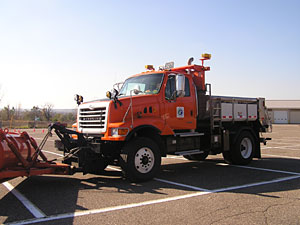|
Photos
|
 |
| State Transportation Commissioner Carol Molnau gets behind the wheel of one of MnDOT's 800 snowplows. (MPR Photo/Laura McCallum ) |
St. Paul, Minn. — Snowplowing became a hot-button issue at the Capitol two years ago, when DFL lawmakers blamed the Pawlenty administration for taking too long to plow the roads. DFLers said MnDOT was short-changing commuters by trying to save money on overtime for snowplow drivers. But MnDOT defended its performance, saying the agency met its snowplowing goals in most parts of the state, and will spend what it takes to clear the roads.
State Transportation Commissioner Carol Molnau said this winter, the agency will use about 1500 snowplow drivers. Fewer than one thousand of them are full-time maintenance workers, the people who are normally responsible for driving the plows. The rest are temporary, including people with desk jobs from other parts of MnDOT who drive snowplows only when more help is needed.
"I think most people understand that snowplow drivers are not a full-time position all the time. We are Minnesota, but now snow every month out of the year," Molnau said. "But I will tell you the people who are behind those snowplows are the most professional, well-trained people to remove snow."
To demonstrate the training, Molnau got behind the wheel of one of MnDOT's 800 snowplows to navigate an obstacle course. All snowplow drivers go through two weeks of training at Camp Ripley.
But the American Federation of State, County and Municipal Employees objects to the increasing use of temporary drivers. The union's business agent, Bob Hilliker, said AFSCME is concerned about the safety of both workers and motorists. He said some MnDOT employees who normally work clerical or other jobs are nervous about driving the massive snowplows, even with the two-week training.
"It's done in September, but it doesn't snow until November or December," said Hilliker. "You don't drive one of those vehicles until then, that's a scary operation. You don't just jump in that truck and learn how to drive it in two seconds."
Hilliker said workers comp claims have increased in the last four years, and he attributes the rise to unskilled people driving snowplows. And Hilliker believes it takes longer to clear the roads using temporary employees. But he didn't cite any statistics indicating traveler safety was compromised. MnDOT officials said there were 72 crashes involving snowplows last year, fewer than in an average year.
Even with the increasing reliance on temporary drivers, MnDOT spent $48 million on snow and ice removal last year. That's up from $40 million for an average winter. And the cost is likely to be even higher this year, according to MnDOT's director of district operations, Bob Winter.
"Diesel fuel prices are increasing considerably. The price of salt has increased substantially over last year. Steel that goes not only goes into the trucks but into the cutting edges that are on the trucks has significantly increased," said Winter. "So just if we have the same winter this year that we had last year, we can expect our costs to be higher."
Winter said the agency has an overall highway maintenance budget of $63 million, so if snow removal costs more, the agency has less money for other maintenance such as mowing. MnDOT officials said they will try to limit overtime for snowplow drivers to hold down costs, but they say overtime may be necessary to clear the roads during a big storm.





